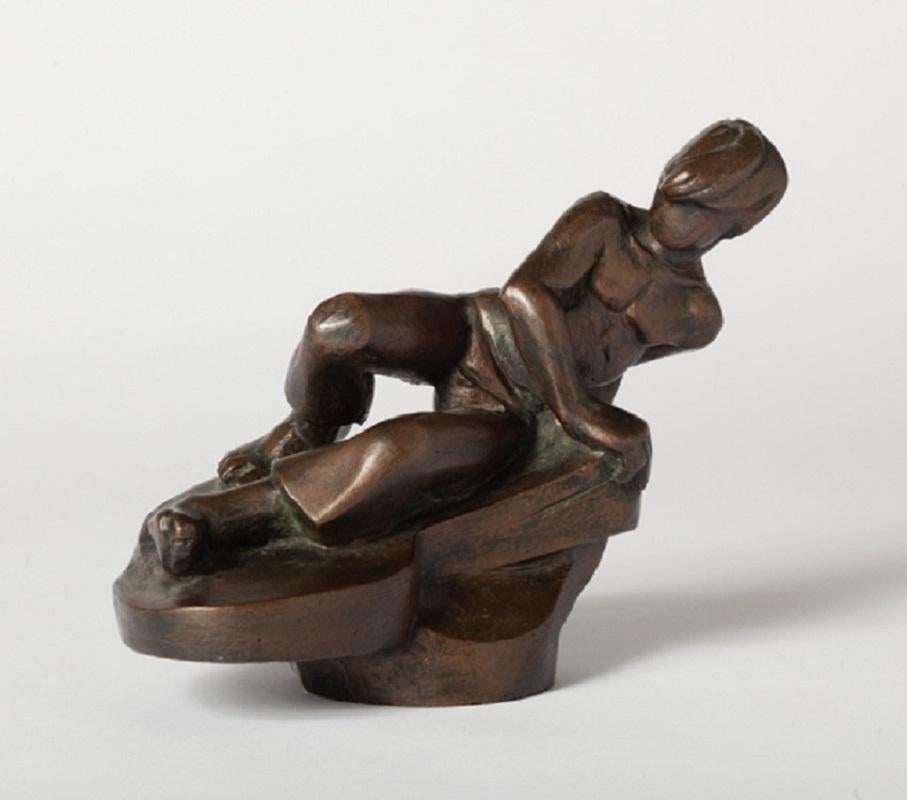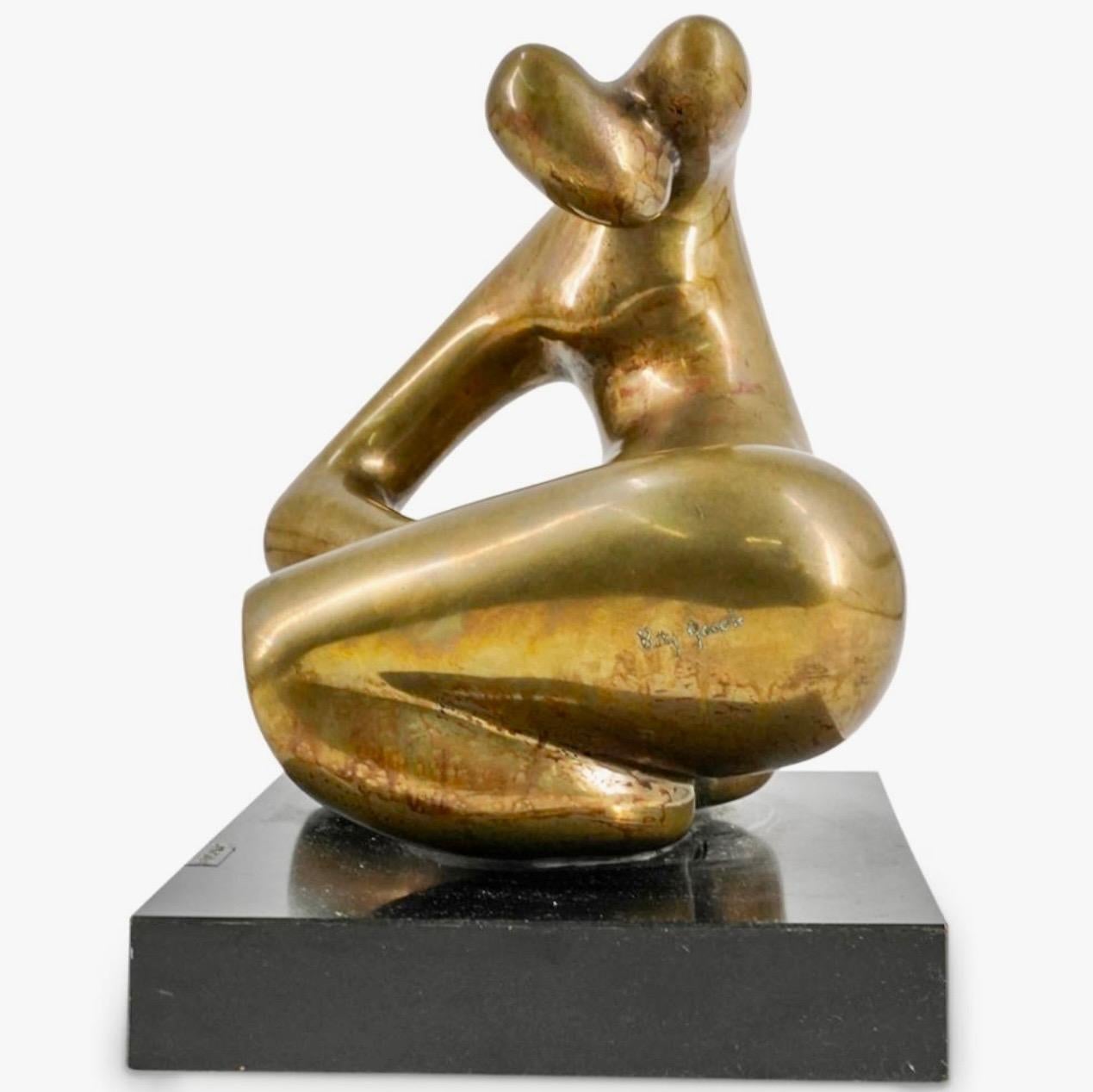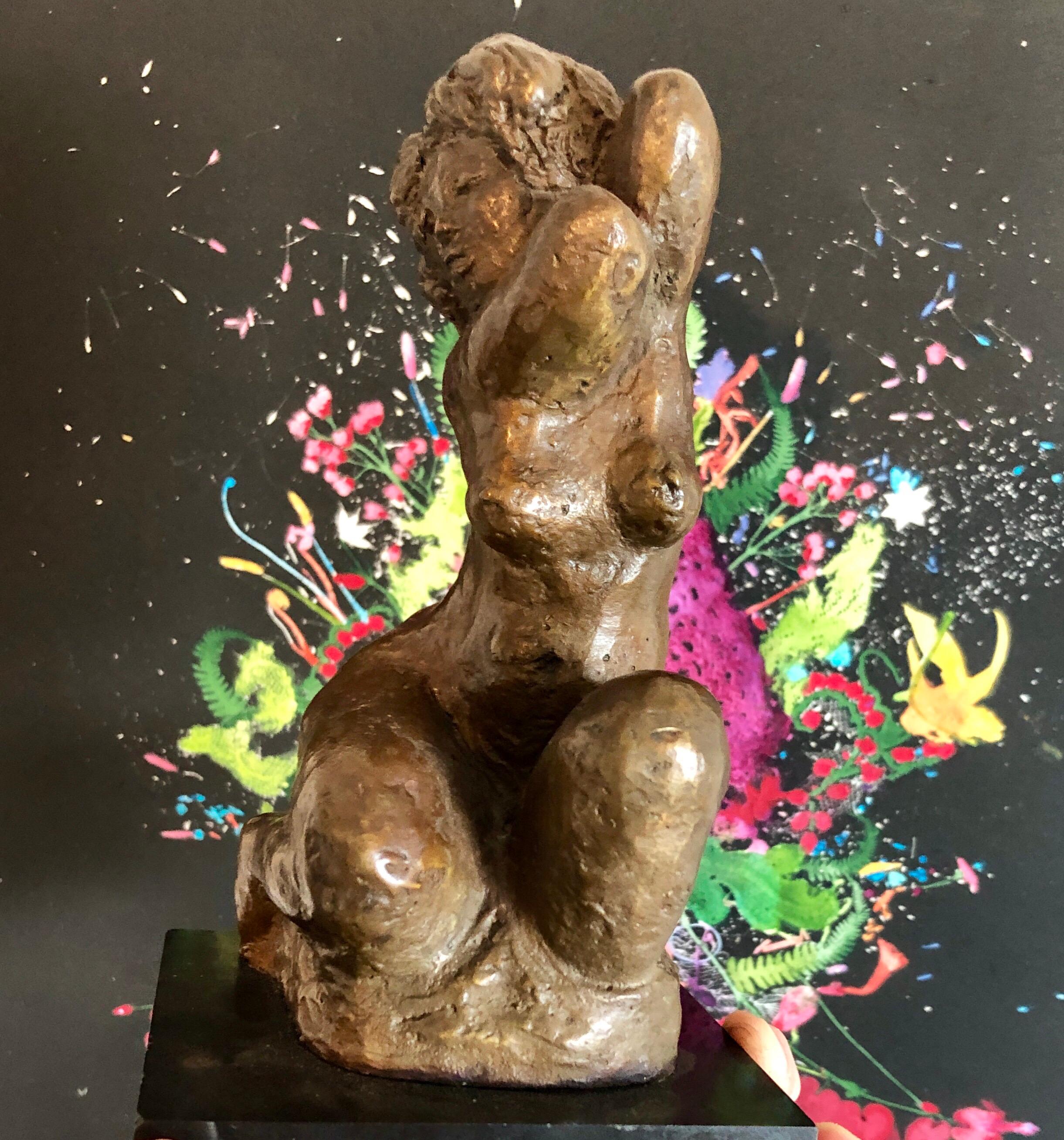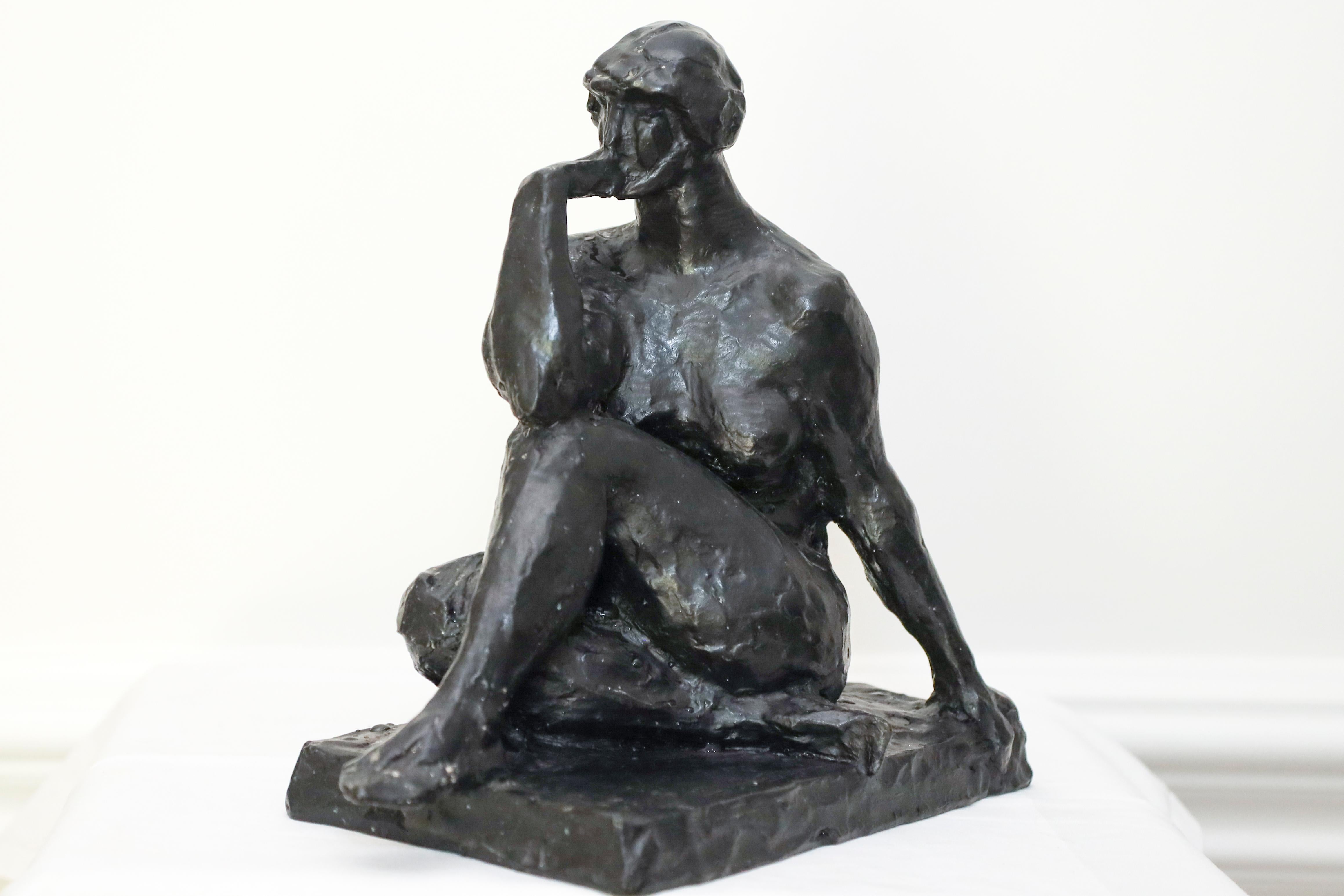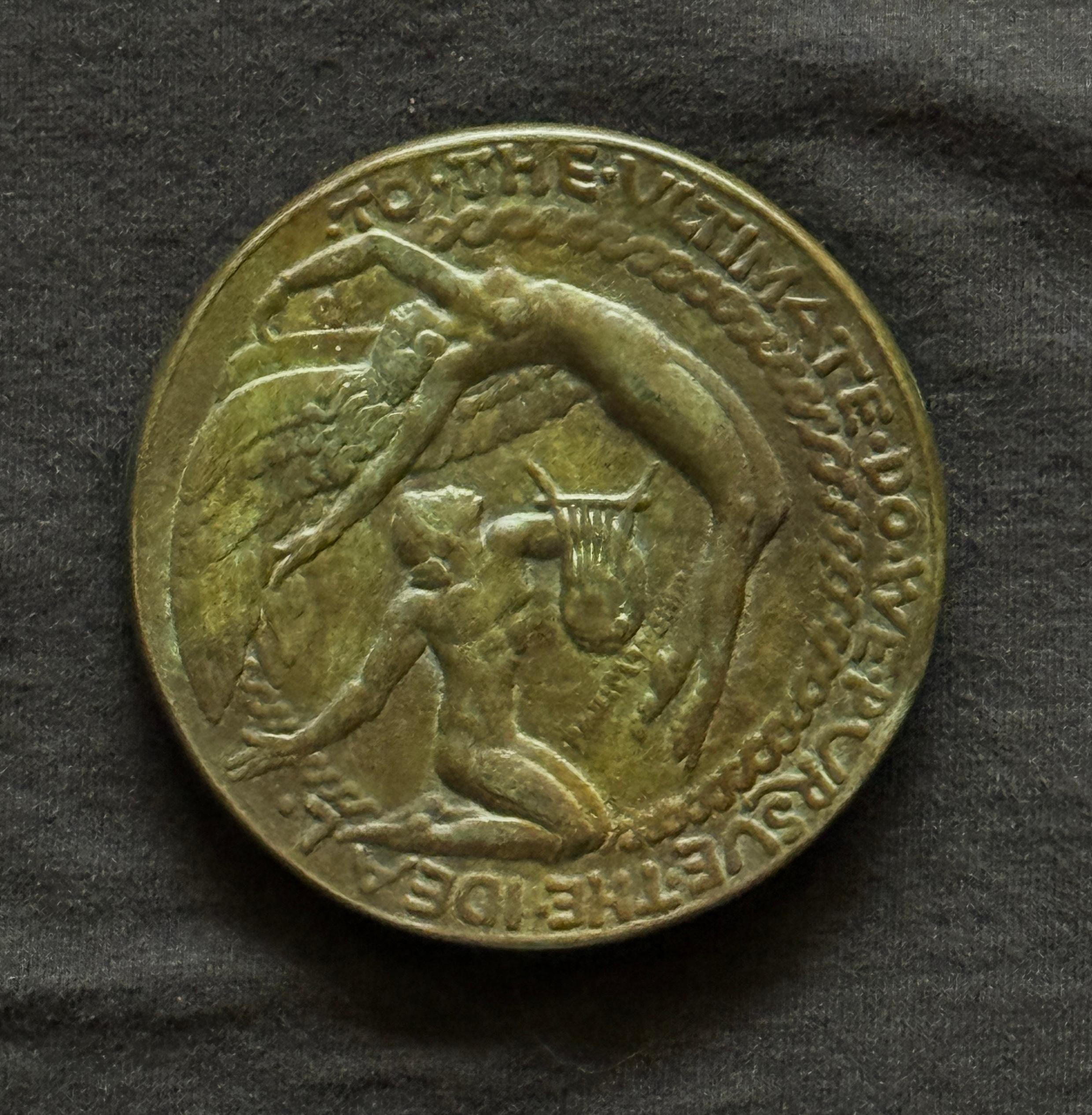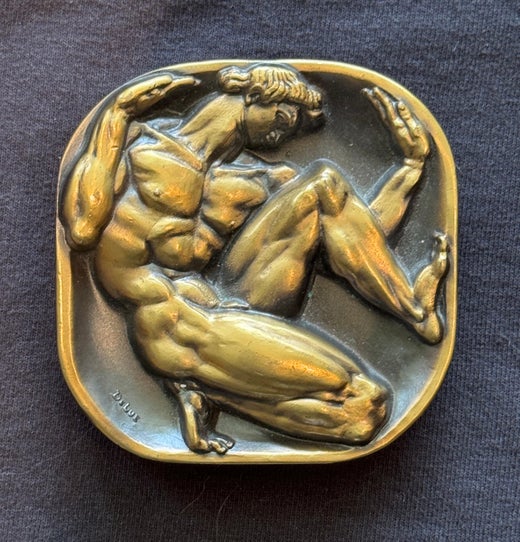Items Similar to Bursting the Bounds
Want more images or videos?
Request additional images or videos from the seller
1 of 10
Donald De LueBursting the Bounds1985
1985
About the Item
This De Lue design was chosen as the 111th issue of the prestigious Society of Medalists series. Both obverse and reverse bear a muscular nude constrained by the rectangular medal's sides, hands and a foot pressed against the sides as if trying to break out of the frame imposed by the medal's shape. The reverse shows the same figure as seen from the other side.
The medal was struck in bronze by the Medallic Art Company of Danbury, Connecticut, and its reported mintage is 750 pieces.
- Creator:Donald De Lue (1897 - 1988, American)
- Creation Year:1985
- Dimensions:Height: 2.75 in (6.99 cm)Width: 2.75 in (6.99 cm)Depth: 0.75 in (1.91 cm)
- Medium:
- Movement & Style:
- Period:
- Condition:DONALD HARCOURT DE LUE (1897-1988) Bursting the Bounds, 1985 Red-gold bronze with deep brown patina in fields and polished edges Signed at lower left: DeLue Stamped: SOM 111th ISSUE / AUG 1985 / DONALD DeLUE.
- Gallery Location:Concord, MA
- Reference Number:
Donald De Lue
Donald De Lue was born in Boston, Massachusetts in 1897. He was an American sculptor, best known for his public monuments. De Lue studied at the Boston Museum of Fine Arts and later served as an assistant to sculptors Richard Henry Recchia and Robert P. Baker. This was followed by five years in Paris where he continued his study, while working as an assistant to various French artists. He returned to the United States where he was engaged by Bryant Baker. In 1940, he was elected into the National Academy of Design as an Associate member and became a full Academician in 1943.
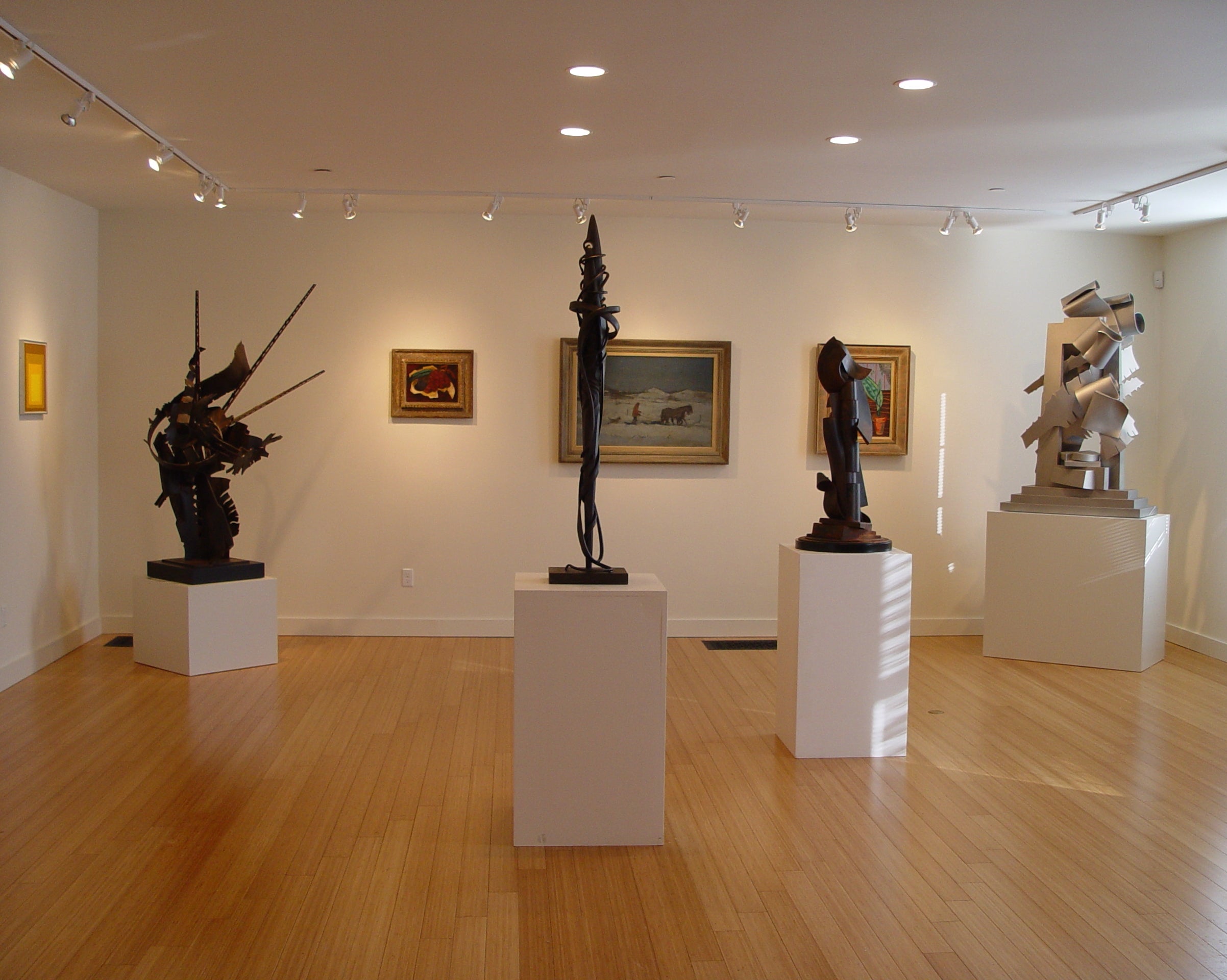
About the Seller
4.4
Vetted Seller
These experienced sellers undergo a comprehensive evaluation by our team of in-house experts.
Established in 1993
1stDibs seller since 2014
50 sales on 1stDibs
- ShippingRetrieving quote...Ships From: Concord, MA
- Return PolicyThis item cannot be returned.
More From This SellerView All
- To The Ultimate Do We Pursue The IdealBy Paul ManshipLocated in Concord, MAThis is an iteration of Paul Manship's medal that features the artist Barry Faulkner on the obverse, and the inscription of that version is marked "Barry Faulkner Painter MXMXV (1915...Category
1910s American Modern Nude Sculptures
MaterialsBronze
- DandelionBy Naomi SavageLocated in Concord, MANAOMI SAVAGE (1927-2005) Dandelion, c.1960 Photo-engraving with painted additions on copper 4 3/8 x 3 ½ inches (plate) Inscribed on the reverse: Naomi Savage / (BK) / 1960? Naomi Savage was born in Jersey City, New Jersey in 1927. From a very early age, Naomi was interested in the arts. Her mother encouraged her to pursue music, and as the niece of famous Dada and Surrealist painter, sculptor, and photographer, Man Ray, she was able to pursue her interests with much support from her family. During high school, Naomi attended a class taught by Bernice Abbott, Man Ray's assistant in the 1920’s, at the New School for Social Research. She later attended Bennington College, where she studied music and the arts. Shortly after college, she traveled to California to study and apprentice with her uncle, Man Ray. Ray was a great inspiration to the young Naomi; he encouraged her to let her imagination create her art. Savage said later in her life that her strongest inheritance enriching her artistic career came from her uncle, Man Ray. "I never forgot his insightfulness," she said. "With him you could try anything - there was nothing you were told not to do, except spill the chemicals. With Man Ray, you were free to do what your imagination conjured and that kind of encouragement was wonderful". In 1950, Naomi married painter, sculptor, and architect, David Savage. Shortly after, the couple moved to Lambertville, New Jersey, residing there for three years before moving to Princeton, New Jersey. She had her first exhibition in 1952 at the Museum of Modern Art in New York City, and exhibited there again in 1960, 1966, and 1968. Her work can now be seen in the permanent collections of the Museum of Modern Art in New York, the Museum of Fine Arts in Boston, the International Center of Photography in New York, the Art Institute of Chicago, the Fogg Museum at Harvard University, and the Noyes Museum in Oceanville, New Jersey. Savage pioneered the use of photographic engravings for which she is best known. With a photographic engraving, the actual metal photographic plate itself is the art. It is described as a kind of topographic photograph with forms in three dimensions and with a variety of metallic surfaces and tones. Some of her most famous photographic engravings involve a series of portraits of her sister, which she manipulated in countless ways over many years. But her most famous photographic engraving (perhaps her most famous work of all) is a fifty-foot long mural she did on the side of the Lyndon B. Johnson Library and Museum in Austin, Texas. Her approach to photography represents an involvement with process as medium, and an interest in art as image manipulation, a pursuit shared by contemporaries like Robert Heinecken, Betty Hahn, and Bea Nettles...Category
1950s American Modern Mixed Media
MaterialsCopper
- Classic FormBy Naomi SavageLocated in Concord, MANAOMI SAVAGE (1927-2005) Classic Form, c. 1970’s Line-cut photo-engraving on zinc-plated copper 9 ½ x 7 ½ inches (plate) Titled and inscribed on artists label verso: “Classic Form” / Collection- Eve Kraft / N.F.S. / Insurance value / $500.00 Artists label on the reverse reads: NAOMI SAVAGE / DRAKES CORNER ROAD / PRINCETON, NEW JERSEYT / PHOTOGRAPH BY / NAOMI SAVAGE Original Kulicke Lucite frame PROVENANCE Ex. Collection Eve Kraft N.F.S. Private collection, Princeton, New Jersey Naomi Savage was born in Jersey City, New Jersey in 1927. From a very early age, Naomi was interested in the arts. Her mother encouraged her to pursue music, and as the niece of famous Dada and Surrealist painter, sculptor, and photographer, Man Ray, she was able to pursue her interests with much support from her family. During high school, Naomi attended a class taught by Bernice Abbott, Man Ray's assistant in the 1920’s, at the New School for Social Research. She later attended Bennington College, where she studied music and the arts. Shortly after college, she traveled to California to study and apprentice with her uncle, Man Ray. Ray was a great inspiration to the young Naomi; he encouraged her to let her imagination create her art. Savage said later in her life that her strongest inheritance enriching her artistic career came from her uncle, Man Ray. "I never forgot his insightfulness," she said. "With him you could try anything - there was nothing you were told not to do, except spill the chemicals. With Man Ray, you were free to do what your imagination conjured and that kind of encouragement was wonderful". In 1950, Naomi married painter, sculptor, and architect, David Savage. Shortly after, the couple moved to Lambertville, New Jersey, residing there for three years before moving to Princeton, New Jersey. She had her first exhibition in 1952 at the Museum of Modern Art in New York City, and exhibited there again in 1960, 1966, and 1968. Her work can now be seen in the permanent collections of the Museum of Modern Art in New York, the Museum of Fine Arts in Boston, the International Center of Photography in New York, the Art Institute of Chicago, the Fogg Museum at Harvard University, and the Noyes Museum in Oceanville, New Jersey. Savage pioneered the use of photographic engravings for which she is best known. With a photographic engraving, the actual metal photographic plate itself is the art. It is described as a kind of topographic photograph with forms in three dimensions and with a variety of metallic surfaces and tones. Some of her most famous photographic engravings involve a series of portraits of her sister, which she manipulated in countless ways over many years. But her most famous photographic engraving (perhaps her most famous work of all) is a fifty-foot long mural she did on the side of the Lyndon B. Johnson Library and Museum in Austin, Texas. Her approach to photography represents an involvement with process as medium, and an interest in art as image manipulation, a pursuit shared by contemporaries like Robert Heinecken, Betty Hahn, and Bea Nettles...Category
1970s American Modern Figurative Photography
MaterialsCopper
- Seeking a FutureBy Philip EvergoodLocated in Concord, MAPHILIP EVERGOOD (1901-1973) Seeking a Future, 1952 Oil on canvas 24 x 18 inches Signed and dated at lower left: Philip Evergood / 52 Heydenryk frame PROVENANCE Alfredo Valent...Category
1950s American Modern Figurative Paintings
MaterialsOil, Canvas
- Space TravelBy Philip PerkinsLocated in Concord, MAPHILIP PERKINS (1907-1970) Space Travel, 1945 Oil on canvas 10 x 8 ¼ inches Dated on canvas verso: 1945 Titled on stretcher bar: Space Travel Unsigned Philip Perkins was bor...Category
1940s American Modern Abstract Paintings
MaterialsCanvas, Oil
- Waterfall (Woodstock, New York)By Grace Hill TurnbullLocated in Concord, MAGRACE HILL TURNBULL (1880-1976) Waterfall (Woodstock, New York), c. 1925 Oil on canvas 14 x 20 inches Unsigned PROVENANCE The Maryland Historical Society The work of pai...Category
1920s American Modern Landscape Paintings
MaterialsCanvas, Oil
You May Also Like
- Reclining BoyBy Dudley Vaill TalcottLocated in Boston, MAInitialed and dated: "DVT 61". From the estate of the artist. In fine condition.Category
Mid-20th Century American Modern Figurative Sculptures
MaterialsBronze
- Three DancersLocated in Santa Fe, NM"A beautiful work, full of Hebald's lyrical expression." To my knowledge, as the representative for the life works of Milton Hebald, (and through extensive research over the past 20...Category
Mid-20th Century American Modern Figurative Sculptures
MaterialsBronze
- Modern Bronze FigureLocated in New York, NYBronze sculpture by Betty Jacob depicts a smooth and curvaceous gilt bronze figure posing on her knees. Signed high on the left thigh and mounted on a blac...Category
1970s American Modern Nude Sculptures
MaterialsBronze
- Bronze Female Nude Sculpture Modernist, WPA, New York Chelsea Hotel ArtistBy Eugenie GershoyLocated in Surfside, FLEugenie Gershoy (January 1, 1901 – May 8, 1986) was an American sculptor and watercolorist. Eugenie Gershoy was born in Krivoy Rog, Russia (Krivoi Rog, Ukraine) and emigrated to New York City in the United States as a child in 1903. Considered somewhat of a child prodigy, Gershoy was copying Old Master drawings at the age of 5. Her interest and talent in art was encouraged from a very young age. Aided by scholarships, she studied at the Art Students League under Alexander Stirling Calder, Leo Lentelli, Kenneth Hayes Miller, and Boardman Robinson. Around this time, she created a group of portrait figurines of her fellow artists, including Arnold Blanch, Lucile Blanch, Raphael Soyer, William Zorach, Concetta Scaravaglione, and Emil Ganso, which were exhibited as a group at the Whitney Museum of American Art. At age 17, she was awarded the Saint-Gaudens Medal for fine draughtsmanship. Early in her career she became an active member of the Woodstock art colony. In Woodstock she experimented by sculpting in the profusion of indigenous materials that she found. Working with fieldstone, oak and chestnut, Gershoy created works based on classic formulae. As she became more interested in the dynamism of everyday life, she found that these materials and her idiom were too restrictive. By the time Gershoy came to Woodstock in 1921 her own individual artistic style was already evident in her sculptures. Eugenie Gershoy worked in stone, bronze, terracotta, plaster and papier-mache. Gershoy’s sculptures were mainly figurative in nature and many of her artist peers such as Carl Walters, Raphael and Moses Soyer, William Zorach and Lucille Blanch, became her subjects. Eugenie Gershoy’s works on paper should not be overlooked. She was the winner of the Gaudens Medal for Fine Draughtsmanship at the tender age of 17. Gershoy married Jewish Romanian-born artist Harry Gottlieb. In the late 1920s and early 1930s, the pair kept a studio in Woodstock, New York. There, Gershoy was influenced by sculptor John Flanagan, who lived and worked nearby. From 1936 to 1939, Gershoy worked for the WPA Federal Art Project. She collaborated with Max Spivak on murals for the children's recreation room of the Queens Borough Public Library in Astoria, New York. She developed a mixture of wheat paste, plaster, and egg tempera, which she used in polychrome papier-mâché sculptures; she was the only New York sculptor to work in polychrome at this time. She also designed cement and mosaic sculptures of animals and figures to be placed in New York City playgrounds. Alongside others employed by the FAP, she participated in a sit-down strike in Washington, DC, to advocate for better pay and improved working conditions for the projects' artists. Gershoy's first solo exhibition was held at the Robinson Gallery in New York in 1940. She moved to San Francisco in 1942, and began teaching ceramics at the California School of Fine Arts in 1946. In 1950, she studied at the artists' colony at Yaddo. Gershoy traveled extensively throughout her life. She visited England and France in the early 1930s, and worked in Paris in 1951. She traveled to Mexico and Guatemala in the late 1940s, and also toured Africa, India, and the Orient in 1955. In 1977, Gershoy dedicated a sculpture to Audrey McMahon, who was actively involved in the creation of the Federal Art Project and served as its regional director in New York, in recognition of the work McMahon provided struggling artists in the 1930s. Gershoy's work is in the collections of the Whitney Museum of American Art, the Metropolitan Museum of Art, and the Smithsonian American Art Museum. Her papers are held at Syracuse University Grant Arnold introduced her to lithography in 1930 and Gershoy depicted many scenes of Woodstock artists and their daily activities through this medium. From 1942 to 1966 Gershoy lived and painted in San Francisco where she taught at the San Francisco Art Institute. She traveled extensively, filling sketchbooks with scenes of Mexico, France, Spain, Africa and India. During her later years Eugenie Gershoy returned to New York City and concentrated on numerous well received exhibitions. Her last exhibition in at Sid Deutsch Gallery included many of the sculptures that were later exhibited in the Fletcher Gallery. John Russell, former chief critic of fine arts for the New York Times, writes about the 1986 Sid Deutsch exhibition: “As Eugenie Gershoy won the Saint-Gaudens Medal for fine draftsmanship as long ago as 1914 and since 1967 has had 15 papier-mache portrait figures suspended from the ceiling of the lobby of the Hotel Chelsea, she must be ranked as a veteran of the New York scene. Her present exhibition includes not only the high-spirited papier-mache sculptures for which she is best known but a group of small portraits of artists, mostly dating from the 30’s, that is strongly evocative.” Eugenie Gershoy is an artist to take note of for several reasons. She was a woman who received great awards and recognition during a time when most female artists were struggling to hold their own against their male counterparts. As a young girl she won a scholarship to the Arts Student League where she met Hannah Small...Category
Mid-20th Century American Modern Nude Sculptures
MaterialsBronze
- Woman Seated A Bronze Sculpture of a Woman by Charles RumseyBy Charles Cary RumseyLocated in Brookville, NYThe bronze sculpture of a woman by Charles Rumsey is undated, but was created at a point in his career where he began to transition from realism to more modern, looser depictions of ...Category
1920s American Modern Figurative Sculptures
MaterialsBronze
- Modern Bronze Relic Sculpture of figure with 3 legs: 'Rhoman Fertility Goddess'By Joshua GoodeLocated in New York, NYInspired by amateur archaeologists such as Heinrich Schliemann who discovered Troy and by past elaborate hoaxes like that of the Piltdown Man, Joshua travels the world performing sta...Category
2010s American Modern Figurative Sculptures
MaterialsBronze
